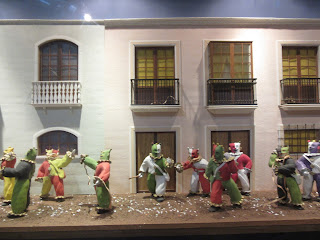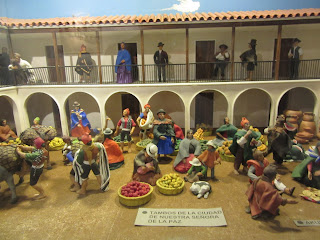After getting up so early the last couple of days to go on walking tours of La Paz and discovering the ancient ruins of Tiwanaku, it was a relief to have a relaxing morning ahead of us to explore the capital city's colonial past. We headed to Calle Jaén, a cobblestone street that is considered the finest colonial street in La Paz and located near the Cathedral and Presidential Palace in Plaza Murillo.
Reached through an adjoining museum, the Museo del Litoral Boliviano commemorated the loss of one of its provinces to Chile. I read that the loss of access to the coast was traumatic and that Bolivians still often speak about this event.
The museum wasn't very noteworthy but it provided an interesting insight into late 19th-century La Paz with many photos from the period of the city and its people.
The Museo Costumbrista Juan de Vargas contained art and photos.
I had already forgotten about the art we saw there four months ago now but I shall remember for a good while the superb ceramic figurine dioramas of old La Paz.
This one depicted a fiesta social or social party during the colonial era.
This gory sight showed the burning at the stake of Túpac Katari, the indigenous Aymara leader of a major insurrection in colonial-era Upper Peru, now Bolivia, in 1781.
This was a representation of akulliko, known as the 'hour of coca-chewing.'
We enjoyed the exhibition of highly sensuous sculptures by Marina Núñez del Prado, a celebrated Bolivian artist whose passion for sculpture was inspired by the work of Michelangelo.
The most impressive museum on Calle Jaén was Museo del Oro aka the Museo de Metales Preciosos, housed in four impressive rooms of pre-Columbian silver, gold and copper works and pieces from Tiwanaku.
Among the most significant pieces of the museum was this San Sebastian Treasure found in 1916, and which had belonged to a person of high rank in Tiwanaku. The stunning collection comprised a headband, necklace, two earmuffs, two shoulder ornaments, four bracelets, over 100 zoomorphic plaques and over 1,000 circular plaques and so much more - all made in gold! As some of you know, that is my favorite color.
Colored in Spanish colonial hues of brilliant reds, blues, greens and pinks, walking down Calle Jaén’s narrow cobblestone street felt like stepping back in time. The four small museums clustered together along La Paz’ finest colonial street was a perfect way to end our stay in La Paz. What a steal it was to visit them as entrance to all of them was less than $3!
The graffiti marked someone's displeasure with the leadership of President Evo Morales.
Named after Bolivian revolutionary Apolinar Jaén, Calle (or street) Jaén was home to some of the most important museums in La Paz.
We spent just a few minutes in the National Ethnographic and Folklore Museum as it was more of a gift shop.
The narrow street was lined with brightly colored houses built in the 16th century although, unfortunately, they look pretty washed out in this photo because it was overcast. There were a variety of boutiques, cafes and entertainment spots in case we grew tired of visiting the museums!
Peeking through the car-free street's wrought-iron doorways and into the courtyards was a delight. Unfortunately, that was all that was allowed at the Casa de Murillo, once the home of Pedro Murillo.
The home displayed collections of colonial art and furniture, textiles, musical instruments and glass and silver that once belonged to Bolivian aristocracy. I would have given my eye teeth to take photos but they weren't allowed. Each guest was also followed by a security guard in case 'someone' wanted to take a photo on the sly.
The museum's courtyard:
This one depicted a fiesta social or social party during the colonial era.
This gory sight showed the burning at the stake of Túpac Katari, the indigenous Aymara leader of a major insurrection in colonial-era Upper Peru, now Bolivia, in 1781.
This was a representation of akulliko, known as the 'hour of coca-chewing.'
We enjoyed the exhibition of highly sensuous sculptures by Marina Núñez del Prado, a celebrated Bolivian artist whose passion for sculpture was inspired by the work of Michelangelo.
The most impressive museum on Calle Jaén was Museo del Oro aka the Museo de Metales Preciosos, housed in four impressive rooms of pre-Columbian silver, gold and copper works and pieces from Tiwanaku.
The monolith from Tiwanaku was dated from 400-1000 AD.
These keros or cups and the small sculpture were discovered among the ruins at Tiwanaku where we'd spent the previous day.
The selection of gold pieces was, not surprisingly, jaw-dropping in the Gold Museum!
Among the most significant pieces of the museum was this San Sebastian Treasure found in 1916, and which had belonged to a person of high rank in Tiwanaku. The stunning collection comprised a headband, necklace, two earmuffs, two shoulder ornaments, four bracelets, over 100 zoomorphic plaques and over 1,000 circular plaques and so much more - all made in gold! As some of you know, that is my favorite color.
Colored in Spanish colonial hues of brilliant reds, blues, greens and pinks, walking down Calle Jaén’s narrow cobblestone street felt like stepping back in time. The four small museums clustered together along La Paz’ finest colonial street was a perfect way to end our stay in La Paz. What a steal it was to visit them as entrance to all of them was less than $3!
The graffiti marked someone's displeasure with the leadership of President Evo Morales.
That afternoon, we flew to Sucre, the constitutional capital of Bolivia located in the south central part of the country, and known as the its most beautiful city. After checking into our small hotel, we wandered a few blocks to the city's main square.
It was a busy and fun place to be on a Saturday night!
Lasagna perfectly fit the bill for Steven's dinner that night. I can't remember what I dined on!
Next post: Sucre's House of Liberty and much more.
Posted on March 5th, 2018, from Littleton, Colorado.





























































That lasagna was delicious!
ReplyDelete